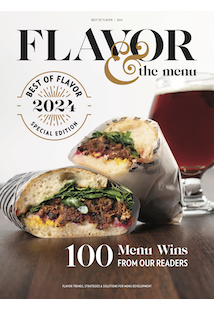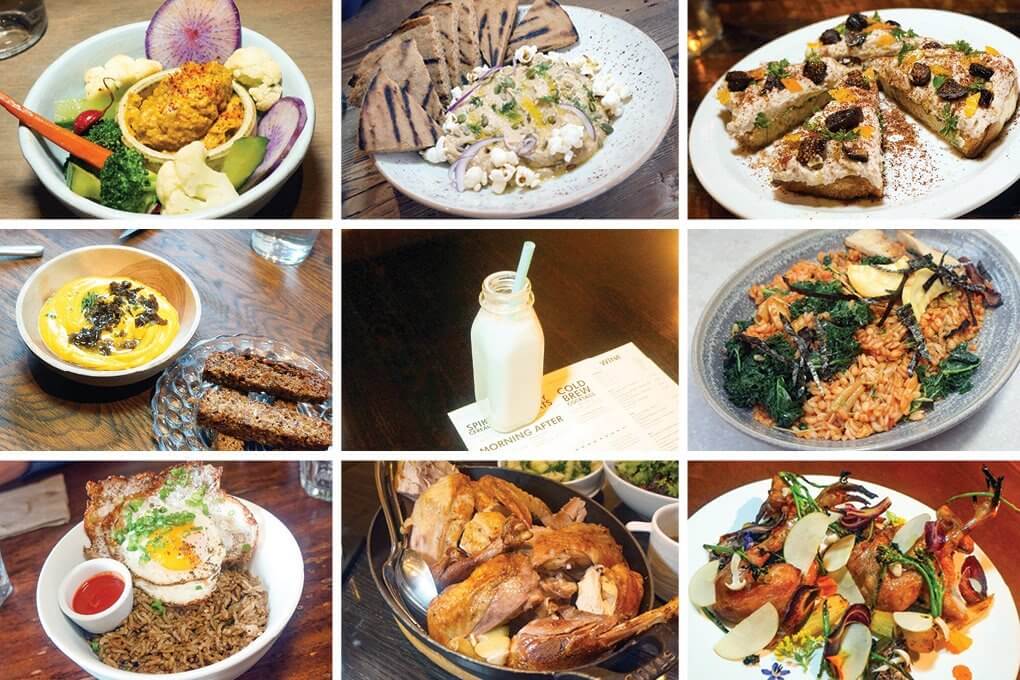This is the second installment of my annual report on insights gained from my team’s research visits to new restaurants in the three major trend-driving cities of New York, Los Angeles and Chicago.
This feature will not only outline emerging opportunities based on patterns identified with menu item and ingredient incidences across our targeted cities, but we’ll also highlight new ideas that involve a single menu item or stem from a single-unit restaurant concept.
Collectively, these trends represent ideation opportunities for foodservice operators in varying segments across the country.
Hummus Beyond Chickpeas

Pumpkin Hummus with raw, cooked and pickled crudité at Rouge Tomate in New York
As the popularity of hummus continues to rise both as a snack and full-serve shareable, chefs are expanding on the standard formula of chickpeas, tahini and garlic to create varieties featuring unexpected base ingredients, including root vegetables, winter squashes, brassicas and a wide variety of beans and legumes. In some cases, tahini is excluded from the recipe and replaced with a blend of herbs, spices and alliums, resulting in unique signature flavors.
At New York’s High Street on Hudson, non-traditional hummus variations are prominently featured, with the offerings often changing from lunch to dinner. During our research, we enjoyed both a Charred Rutabaga Hummus topped with spicy green chermoula, and a silky-smooth Roasted Vegetable Hummus garnished with roasted onion and black sesame oil.
Cranberry Bean Hummus serves as a toast topper at Chicago brewpub Forbidden Root, served on grilled sourdough cut into shareable slices and topped with bits of dried fig, orange supremes and a generous sprinkle of sumac powder.
The variety of accompaniments served with hummus is broadening as well. At The Little Beet Table in Chicago, Antonio Mendez, executive chef, offers both a Roasted Cauliflower Hummus whimsically garnished with toasted pepitas and popcorn, and a Roasted Red Pepper Hummus served with an attractive assortment of vegetable crudité, including stem-on baby carrots and radishes.
The Pumpkin Hummus at Rouge Tomate in New York features a creative assortment of raw, cooked and pickled vegetables. And the Celery Root Hummus at nearby Quality Eats is topped with a roasted and chopped beet “tabbouleh” and served with wood-grilled slices of focaccia.
One of the most notable hummus dishes we encountered was a traditional preparation enhanced by the addition of fresh turmeric root. At flexitarian restaurant Beefsteak in Los Angeles, Executive Chef Marcel Vigneron purées fresh turmeric, which he keeps on hand for many of the cold-pressed juices and smoothies on offer, and folds it into his chickpea-based hummus, resulting in a spread with an eye-catching fluorescent yellow color. The hummus is also creatively cross-utilized as a salad dressing, tossed with baby kale and an assortment of roasted vegetables.
Hummus has evolved on menus to its current status of “darling of dips,” making menu appearances as a shared plate, snack, side dish, sandwich spread and salad dressing. The many ingredient and flavoring options available make this a menu item with ample room for further innovation.

Roasted Vegetable Hummus has a smooth consistency at New York’s High Street on Hudson

Popcorn and pepitas perk up the Roasted Cauliflower Hummus at Chicago’s The Little Beet Table

Cranberry Bean Hummus at Forbidden Root in Chicago is sprinkled with sumac
Fried Rice: Going Global

Adobo Fried Rice at L.A.’s République
In the ongoing quest to develop new menu offerings based on less costly ingredients, chefs are creating variations of fried rice, incorporating flavor components that reach well beyond those found in the traditional Chinese dish. Ingredients from across the globe are making their way into these dishes, as are a broad assortment of grains and heirloom rices.
The Little Beet Table serves a dish of Crispy Pearl Rice that is griddled rather than fried. Prepared in a similar fashion to hashed browned potatoes, the rice is crisped on a flat griddle until one side is nicely browned, and then tossed with garlic, soy, ginger, slices of blistered shishito peppers and topped with a sunny-side egg. This technique produces a pleasing textural combination of both soft and crunchy rice grains.
Chef/owner Josef Centeno incorporates the spicy North African bird’s eye chile into his dish of Green Piri Piri Rice at P.Y.T. in Los Angeles, stir-frying the rice and chile paste with lime zest and a generous handful of chopped green herbs, finishing the dish with an over-easy egg.
Korean kimchi was found in several fried rice dishes, including the Kimchi Barley and Fried Rice at M Café in Los Angeles, studded with chunks of roasted oyster mushrooms and Brussels sprouts and topped with fried basil, shredded nori and a spicy miso drizzle. The Kimchi Fried Rice at nearby République was garnished with tender shreds of pulled short rib and a soft farm egg. République’s menu also features a Filipino-inspired Adobo Fried Rice, stir-fried to a deep brown with adobo seasoning and crispy bits of fried pork belly.
One of the more creative grain combinations is featured in the Chickpea Skillet Rice served at New York’s Quality Eats, stir-fried in bacon fat with scallion, garlic and bacon bits before receiving the classic fried egg topping.
While many chefs opted for an egg topping on their fried rice dishes, Miles Thompson, executive chef of Michael’s in Santa Monica, Calif., chose a unique garnish for his Black Garlic Fried Rice, topping the crispy forbidden rice with vinegar-roasted baby turnips served with the stems and leaves intact.
And in one cleverly executed dish, the Hudson Valley Foie Fried Rice at 21 Greenpoint in Brooklyn, N.Y., global flavors are given a touch of luxury by Executive Chef Sean Telo. The fried rice/paella hybrid incorporates foie gras with Portuguese linguiça sausage and allspice that is first stir-fried and then oven-baked in cast iron until a crunchy crust is formed on both the top and bottom.

Global ingredients intersect in this Kimchi Barley and Fried Rice at M Café in Los Angeles, adding complexity to an otherwise simple dish.

The Crispy Pearl Rice at The Little Beet Table in Chicago incorporates shishito peppers and is topped with a sunny-side-up egg.
Boozy Milk: Hopefully Not For Breakfast

An enticing presentation of “Boozy Milk” adds a fresh note to any brunch menu. Cinnamon Toast Crunch milk is spiked with spiced rum at Nighthawk in Los Angeles.
A single-unit restaurant that captivated us during our Los Angeles research was Nighthawk in Venice, Calif., a “breakfast bar” concept specializing in highly creative takes on traditional breakfast fare and an offering of “breakfast-themed cocktails.”
The food menu features a greater number of deftly executed, chef-driven signature dishes than can be listed here, but standouts include: a Duck Egg Scramble with foie gras, wild mushrooms and a duck-porcini jus; Benedict Fries topped with shaved country ham, melted raclette cheese, sliced Peppadew peppers, a sunny-side egg and smoked paprika hollandaise; a Duck Confit and Purple Potato Hash topped with a 63-degree egg and habanero relish; and a Breakfast Burger featuring candied bacon, crispy potato strings, a sunny-side egg, fried sage leaves and cracked peppercorn aïoli.
Even more impressive was the cocktail menu, which includes a whimsical assortment of drinks such as a Bloody Mary Slushie, an Orange Mimosa made with Tang, and a Banh Mi Michelada that combines beer with housemade tomato juice, nuoc cham and gochujang, with a shaker of MSG served alongside.
The true highlight of the menu, however, was a delicious offering of “Boozy Milk”—cereal-infused milks spiked with various liquors. The idea of “cereal milk” is not new, having been conceived and even trademarked nearly a decade ago by Christina Tosi, chef and owner of New York’s Momofuku Milk Bar chain. But the addition of alcohol puts a decidedly adult spin on the concept.
The liquors are well matched to the cereal milk flavors and include: Cinnamon Toast Crunch with Spiced Rum; Honey Nut Cheerios and Bourbon; and Cocoa Puffs with Vanilla Vodka. The milks are kept chilled in clear miniature milk bottles, with the liquor added to order. A straw finishes the presentation.
The bright flavors of these craveable spiked milks make other dairy-driven cocktails such as the White Russian or Brandy Alexander seem pedestrian by comparison, and their addition could provide significant differentiation for virtually any brunch menu.
Serving The Whole Bird

Chicken-fried poussin at 21 Greenpoint in Brooklyn, N.Y.
Yet another menu item gaining notable traction in the nation’s newest restaurants are chickens and other related poultry, served whole. This style of preparation results in dramatic plate presentations and represents yet another opportunity to leverage the popularity of shared plates with dining consumers.
Chef Antoine Westermann has created a restaurant in New York dedicated to this concept. Le Coq Rico offers a menu of heritage-breed birds that Westermann sources from local farmers in the Hudson Valley and Catskill Mountains. These are slower-developing breeds that are allowed to grow from 98 to 130 days before harvesting, in contrast to the 35 to 42 days that conventionally raised chickens are given to mature.
Five varieties are on offer each day, including a 130-day Catskill Guinea Fowl and a 120-day Brune Landaise, which Westermann considers his signature bird. The chickens are oven-roasted and presented whole at the table before returning to the kitchen for carving, and served simply with a lightly dressed salad and an intensely rich chicken jus.
All parts of the birds are used, making their way onto the menu in pâtés, terrines and shareable dishes, such as a Roasted Chicken Liver on Horseradish Toast and an Apple and Heart Brochette that is skewered and grilled.
All of this would amount to so much menu gimmickry were it not for the quality and flavor of the finished product. The birds served at Le Coq Rico possess an explosively rich and complex poultry flavor that is apparent from the first taste.
Of course, this is a highly specialized restaurant appropriate for only the largest metropolitan locations. However, while Le Coq Rico takes the “whole bird” concept to its ultimate expression, chefs at many new mainstream venues have incorporated the idea onto their menus as well.
Also in New York, restaurant Le Turtle has garnered attention from both restaurant critics and Instagramming diners with its Whole Sasso Chicken, yet another slow-growing heritage breed. The chicken is brined for two days before roasting, and is brought to the table, head and feet intact, on a platter of smoldering hay. While this presentation takes visual drama to a higher level, the chicken also delivers with a clearly superior poultry flavor.
From an execution standpoint, one challenge in offering a whole bird is the requisite cooking time. One solution is to prepare the chicken “spatchcock” style, which involves removing the back and breast bones and flattening the bird, which not only significantly reduces the cook time but promotes more even cooking. At Hearth in New York, Marco Canora, chef/partner, employs this technique for his Whole Spatchcock Chicken, which he serves with an arugula salad and a pan jus spiced with Calabrian chile.
In Los Angeles, Kris Tominaga, executive chef at Mardi, takes the procedure a step further by also removing the leg bones, resulting in an evenly crisped Whole Chicken with Garlic Brown Butter, served on a large wooden board adorned with a mixed salad of greens, Persian cucumber, watermelon radish and pea tendrils.
Another path to quicker cooking is to simply offer a smaller bird. Both Michael’s in Los Angeles and 21 Greenpoint in Brooklyn serve a poussin, which is a young chicken that is harvested at about four weeks, the former garnishing the roasted bird with lavender, sunchoke and apple, and the latter chicken-frying the poussin and serving it on a bed of sautéed cress with a creamy rutabaga purée. Cornish game hens are yet another option, such as the one on offer at Here’s Looking At You in Los Angeles, served chicken-fried with a peanut mole glaze and shaved jicama.

At Mardi in Los Angeles, Kris Tominaga spatchcocks his chicken and removes the leg bones for an evenly crisp Whole Chicken with Garlic Brown Butter.

Le Coq Rico in New York serves simple yet intensely flavorful whole chicken. The Catskill Guinea Fowl is allowed to develop slowly, for 130 days.

The whole-chicken trend includes smaller birds, allowing for quicker cooking time. Michael’s in Los Angeles offers this Whole Roasted Young Chicken with lavender, sunchoke and apple.
Shareable Seafood: In The Bag

Seafood boils offer a party in a bag. Shellfish and sides can be customized, such as shrimp with corn, potato and sausage at Mad Boiler in Chicago.
The New Orleans-style seafood boil has taken Chicago by storm over the past year, as new restaurants with names such as The Angry Crab, The Crazy Crab, The Crab Pad, Mad Boiler, Asian Cajun and Captain’s Catch continue to expand across the city.
The menus of these restaurants are all similar, but they offer dining guests nearly endless customizability. Dishes are built from four ingredient categories. First is a selection of shellfish, including various species of crab, whole or headless shrimp, clams, mussels, lobster and crawfish. Guests then choose a flavoring sauce or rub, such as garlic butter, sweet chile, lemon pepper or Cajun spice. Next, one of four heat levels from mild to extra-spicy is chosen. Add-on ingredients are then selected, including corn cobbettes, boiled potatoes, sausage, rice and noodles.
The selected seafood and add-ons are then boiled in a pot, strained and placed in a large plastic bag to which the sauce or rub is added, and then sealed. The captured steam expands and inflates the bag, which is brought to the table on a flat tray, making for an impressive presentation of a dish that is ideal for sharing. The meal is consumed right from the bag, with the aid of steel shell crackers and picks, forks, chopsticks and, for the prudent, large plastic bibs.
The growing popularity of this dining style is understandable. Enjoying a meal at these venues during prime time puts one in the middle of a huge party, with diners sitting elbow-to-elbow at communal tables, getting messy as they dig into boldly flavored, high-quality seafood accompanied by a microbrew, chilled sake or craft cocktail.
While this format may seem like a niche opportunity, full-service operators could menu a seafood boil as an LTO or chalkboard special, creating a single, specific offering of seafood and accompaniments in the bag, but allowing the guest to choose from a selection of sauces, rubs and heat levels—retaining some of the customizability and all of the shareability. This could be a particularly opportune special offered on Fridays and throughout the Lenten season.










